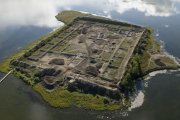 It seems that the scientists successfully solved the riddle of Por-Bazhyn. What kind of building is it, when was it built? What was the purpose of Por-Bazhyn? The scientists promised to find answers to these questions when they were carrying out archeological excavations at Por-Bazhyn in 1007-2008. Now there are answers, thanks to the co-operation of archeologists and geologists, and with the use of latest methods of scientific research.
It seems that the scientists successfully solved the riddle of Por-Bazhyn. What kind of building is it, when was it built? What was the purpose of Por-Bazhyn? The scientists promised to find answers to these questions when they were carrying out archeological excavations at Por-Bazhyn in 1007-2008. Now there are answers, thanks to the co-operation of archeologists and geologists, and with the use of latest methods of scientific research.
In 1980's a new interdisciplinary scientific field appeared - geoarcheology. Por-Bazhyn became practically the first geoarcheological project organized by the Cultural Fund "Fortress Por-Bazhyn", within the framework of activities of Russian Fund of fundamental research.
"The unique aspect of the scientific expeditions to Por-Bazhyn lies in their complexity, - the scientific leader of the project "Por-Bazhyn", the head of archeology department of Institute of ethnology and anthropology RAN, Irina Arzhantseva. - It was the first time in my memory that archeologists had the possibility to form a united multidisciplinary team, which consisted not just of archeologists but also of architects, restorers, and those in natural sciences - geophysicists, geomorphologists, hydrologists, soil scientists and permafrost experts.
At the XIV convention of the Russian Geographic Society (RGO), which took place on December 14, 2010 in Sankt-Peterburg, at one of the meetings of the landscape science section a group of scientists from the leading universities of Moscow, Sankt-Peterburg, Kazan, (A.V. Panin, I.A. Arzhantseva, M.A. Bronnikova and others) presented a paper "Geoarcheology: place of geography (example of project "Por-Bazhyn")". We now present the salient points of this paper to our readers.
Fortress, residence of a Chinese princess, or a monastery?
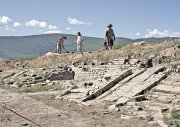 Por-Bazhyn (50836"53 N latitude, 97*23"07 E longitude) is a clay structure, outwardly resembling ruins of a fortress, on a small (6 hectares) low island in a shallow (average 0.5-0.6 m) lake Tere-Khol, in South-Eastern Tuva. The first investigator of this monument was Russian archeologist D.A. Klementz, who visited it in 1891 on assignment from east-Siberian section of Russian Geographic Society. Klementz was the first person to point out the similarity of the layout of Por-Bazhyn to that of Kara-Balgasun - the capital of Uighur Khanate, which is located 200 km to the south, on the territory of today's Mongolia. On this basis, Klementz dated the monument to that epoch - middle VIII - middle IX centuries.
Por-Bazhyn (50836"53 N latitude, 97*23"07 E longitude) is a clay structure, outwardly resembling ruins of a fortress, on a small (6 hectares) low island in a shallow (average 0.5-0.6 m) lake Tere-Khol, in South-Eastern Tuva. The first investigator of this monument was Russian archeologist D.A. Klementz, who visited it in 1891 on assignment from east-Siberian section of Russian Geographic Society. Klementz was the first person to point out the similarity of the layout of Por-Bazhyn to that of Kara-Balgasun - the capital of Uighur Khanate, which is located 200 km to the south, on the territory of today's Mongolia. On this basis, Klementz dated the monument to that epoch - middle VIII - middle IX centuries.
The first excavations were done only almost 60 years later, by the worker of Institute of Ethnography of AN USSR, S.I. Vainshtein. Like Klementz, he dated the monument as belonging to the time of the Uighur Khanate and noted that the fortress was built, most likely, by Chinese craftsmen according to the traditions of classical Chinese architecture. Vainshtein offered that Por-Bazhyn was one of a whole series of defense fortresses, built by the second ruler of the khanate, Boyan-Chur, on the territory of contemporary Tuva, and that it is precisely the one which he had built in 750 C.E. according to the so-called Selenginsk inscription.
Vainshtein's hypothesis soon became the only one, and was widely accepted and disseminated by other investigators, even though it was based solely on speculative foundation and contained many assumptions. So, the Selenginsk inscription says: "then by a spring…I arranged to set up my…encampment", and makes no mention of a lake. As Vainshtein explained it, is possible that the lake originated later, and he referred to folkloric sources. In this way, there is no convincing basis to connect the "white encampment of Boyan-Chur" from the Selenginsk inscription with Por-Bazhyn.
The specifics of the layout and the historical context cause the investigators to this day to offer various hypotheses about the functional purpose of Por-Bazhyn:
Fortified structure (the first hypothesis, which gave rise to the name - "fortress";
Palace complex - summer residence of the khan, or Boyan-Chur's present for his young wife, Chinese princess Nin-ho;
Memorial complex for Boyan-Chur himself;
Monastery of Buddhist or Manichean priesthood.
Por-Bazhyn was built on the island
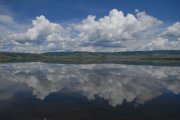 No less problematic is the natural location of this monument. Vainshtein was the first to doubt that the monument was built on the island. S.I. Vainshtein: it is hard to believe that tens of thousands tons of building materials could have been brought there over water. The military qualities of such an isolated fortress are also dubious. Folklore sources again help to explain away these questions. There is a local legend that the fortress was built on the mainland,, and only later the water rose from a well within the fortress - and that is the origin of Tere-Khol lake. There were also speculations about its possible artificial origin (damming).
No less problematic is the natural location of this monument. Vainshtein was the first to doubt that the monument was built on the island. S.I. Vainshtein: it is hard to believe that tens of thousands tons of building materials could have been brought there over water. The military qualities of such an isolated fortress are also dubious. Folklore sources again help to explain away these questions. There is a local legend that the fortress was built on the mainland,, and only later the water rose from a well within the fortress - and that is the origin of Tere-Khol lake. There were also speculations about its possible artificial origin (damming).
They are assumptions. The lake originated in a natural way at the turn of Pleistocene and Holocene (about 11,000 calendar years ago), as a result of damming of the conical inner delta of Balyktyg-Khem river.
Scientists discussed it in 2008
"Investigations show that the lake is of natural origin, remarked geomorphologist Andrei Panin, vice-dean of Geographic department of MGU. - The earlier hypotheses about its artificial origin were shown to be a myth. Beautiful, but a myth anyway. Tere-Khol is ten thousand years old. The center of the island, where the fortress is located, is actually a glacier. The melting of the permafrost also is the main threat to the monument. I assure you, the water can reach the walls of the fortress no sooner than in 100 years."
More from the presentation by A. Panin at the convention of Russian geographic Society:
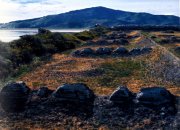 " At the time when the monument was built, the area of the lake was practically free of people: the phosphorus content, which is the main geochemical indicator of anthropogenic activity, increases only in the uppermost 10-12 cm of lake sediments, which corresponds to 2-3 centuries (the level of Por-Bazhyn is in the depth of about 40 cm). according to dendrochronologic data, the climate at the time of construction was warm and very dry, and the level of the lake was lower that now.
" At the time when the monument was built, the area of the lake was practically free of people: the phosphorus content, which is the main geochemical indicator of anthropogenic activity, increases only in the uppermost 10-12 cm of lake sediments, which corresponds to 2-3 centuries (the level of Por-Bazhyn is in the depth of about 40 cm). according to dendrochronologic data, the climate at the time of construction was warm and very dry, and the level of the lake was lower that now.
Local lake sediments of varying composition were used for the construction; the Por-Bazhyn island itself is composed of the same. South and north-east of the island , on the bottom of the lake, trenches were discovered, the apparent source of the clay materials (at the time this was the edge of the island). Analysis of fired materials (bricks, roof tiles, tiles) showed that material was used for their manufacture from a particular lithological stratum of sediments on the bottom of the valley (shore sediments).
The absence of traces of habitation of the monument is one of the mysteries of Por-Bazhyn. This is associated with the sparsity of the cultural layer, which does not allow a confident interpretation and the dating of the monument by archeological methods. In two seasons of excavations (2007-2008), the main finds consisted of multiple roof tiles, ceramic reliefs of protector spirits, an iron dagger, a stone chalice, fragments of ceramics, a silver earring, and iron construction nails. The most expressive chronological markers were the terminal discs of roof tiles and the silver earring ( of srostkinsky type). These artifacts yield a relatively wide chronological range of VIII-IX centuries.
The temple was built by Manicheans, who never got to use it
More exact dating of the monument was achieved by the method of comparison of mass spectrometric carbon-14 dates of year-rings of a larch tree trunk which was synchronous to the monument.
The results showed that the most probable time of construction was the '70's of the 8th century, that is, 20-30 years later than it was believed. Consequently, all the hypotheses connected with Boyan-Chur, who died in 759, can be ruled out. His son and heir Byogyu-Kagan declared Manichaeism as state religion. If we suppose that Por-Bazhyn was a Manichaean cultic complex, it would also explain such details of its construction as the complexity of its inner routes of communication and its similarity to Kara-Balgasun. The Khan was building a second capital or a royal temple for himself in the form of a smaller copy of the capital, where he could live with his co-believers in seclusion.
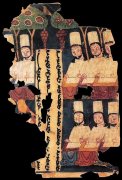 Considering the principles of Manichaeism, striving for maximum isolation from the outer world would fully explain the choice of a location in a deserted valley on an unreachable island. In 779 Byogyu-Kagan was killed during an anti-Manichaean revolt. If the temple complex Por-Bazhyn was built around 778-779 C.E., immediately before the anti-Manichaean revolt, it would explain the absence of traces of habitation. They simply never got to use it.
Considering the principles of Manichaeism, striving for maximum isolation from the outer world would fully explain the choice of a location in a deserted valley on an unreachable island. In 779 Byogyu-Kagan was killed during an anti-Manichaean revolt. If the temple complex Por-Bazhyn was built around 778-779 C.E., immediately before the anti-Manichaean revolt, it would explain the absence of traces of habitation. They simply never got to use it.
From the book of L.P. Kyzlasov, "Northern Manichaeism and its role in cultural development of the peoples of Siberia and Central Asia":
- The Manichaean teachings were declared as state religion by Uighur Eltutmysh-kagan (that is Byogyu-kagan, 759-779), who returned from a China campaign to Ordubalyk on river Orkhon in 763. The khan himself was converted to Manichaeism already in 762, while in Chinese town of Loyang. However, 16 years later after confirmation of the new faith, in 779 an anti-Manichaean revolt took place in Ordubalyk. Byogyu-kagan, his sons and some Sogdian Manichaeans were killed. But many of the followers of the teachings of Mani, as it can be thought now, managed to escape to the Yenisei. Even 16 years later, in 795, a new kagan dynasty headed by Alp Kutlug (795-805) re-established the Manichaean faith in Ordubalyk.
Manichaeism is a syncretic religious teaching composed of Babylonian and Chaldean, Judaic, Christian, Iranian (Zoroastrianism), and Gnostic ideas of the Persian Mani, or manes. Together with Zoroastrianism and Mithraism, Manichaeism was one of the most influential Iranian religions.
The teachings of Mani - it is a dualistic teaching about the eternal battle of light and darkness, good and evil. Taking its source from Gnosticism, it demanded from the higher circles of followers extremely strict asceticism, especially in the area of food, sex life, and physical work. The lay Manichaeans, who always composed the majority of believers, observed only a part of the necessary rules, which did not prevent the possibility of their salvation.

